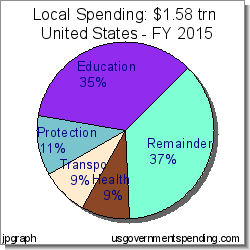a usgovernmentspending.com briefing:
Estimated FY 2015 Spending for Governments in the United States
In fiscal year 2015 the governments in the United States are expected to spend about 35 percent of
Gross Domestic Product. Most of the money goes for health care, education, pensions, defense, and welfare
programs. Health care spending is split mainly between federal and state governments; education
spending occurs mainly at the local government level; pension spending is primarily the federal
government’s Social Security program and the states’ government employee pension programs.
Government Spending: Federal, State, Local
Governments in the US will spend $6.2 trillion in 2015.
Table 2.01: Total Spending in 2015
In fiscal 2015 the federal government estimates spending will be $3.8 trillion, of which $0.6 trillion will be transferred to states and local governments. State spending for 2015 is "guesstimated" by usgovernmentspending.com at $1.5 trillion and local government spending is "guesstimated" by usgovernmentspending.com at $1.6 trillion.
Total spending at all levels of government in the United States is "guesstimated" by usgovernmentspending.com to be $6.2 trillion in 2015.
Government Spending: the Big Picture
The four big programs each cost about one trillion dollars a year.
Table 2.02: Total Spending Breakdown FY 2015
Where does all the money go? It is really quite simple. Governments at all levels, federal, state, and local, spend about $1.2 trillion a year on pensions, including Social Security and government employee pensions. Governments spend about $1.4 trillion a year on health care, principally Medicare and Medicaid. Governments spend about $0.9 trillion a year on education at all levels, principally at the local government level. The federal government spends about $0.8 trillion a year on defense, including the Departments of Defense, State, and Veterans Affairs. Governments spend $0.5 trillion on welfare programs other than Medicaid. All other spending amounts to $1.4 trillion, including interest on the national debt. The grand total of all the spending is $6.2 trillion.
Pie Chart of Total US Government Spending
Although the four big government programs — pensions, health care, education, and defense — each cost about a trillion dollars a year they are distributed unequally between the levels of government.

Chart 2.04: Total Spending Details
Total government spending in the United States, including federal, state, and local governments, is expected to total $6.23 trillion in 2015. The total features five major functions. Of the total spending, health care takes a 22 percent share, pensions a 20 percent share, education a 15 percent share, and defense a 13 percent share. Welfare, the fifth largest function, takes a 7 percent share of spending. All other functions, including interest on the debt, take only 23 percent of spending.
Pie Chart of Federal Government Spending

Chart 2.05: Federal Spending Details
Federal spending is budgeted at $3.76 trillion for FY 2015, and includes four major functions. Health care, principally Medicare and Medicaid, takes a 27 percent share; pensions, principally Social Security, take a 26 percent share; defense, including foreign policy, veterans, and foreign aid, is 22 percent of spending; and welfare takes 10 percent of spending. All other spending, including interest on the national debt, takes 16 percent of federal spending.
Notice that education is not a major item in federal spending.
Pie Chart of State Government Spending
 <
<
Chart 2.06: State Spending Details
State government spending, as "guesstimated" by usgovernmentspending.com, will total about $1.53 trillion in FY 2015, and features five major functions. Health care spending takes 36 percent of spending, education has a 19 percent share, state government pensions a 15 percent share, and welfare 8 percent. Transportation takes an 7 percent share of state spending. All other spending takes a 14 percent share of state government spending.
Pie Chart of Local Government Spending

Chart 2.07: Local Spending Details
Local government spending, as "guesstimated" by usgovernmentspending.com, will total about $1.58 trillion on FY 2015, and features two major functions. Biggest program by far is education, K-12 schools, taking a full 35 percent of local spending, followed by protection — police, fire and justice system — at 11 percent. Then comes health care at 9 percent and transportation at 9 percent. All other programs, at 37 percent of total, each take less than 7 percent of local government spending.
